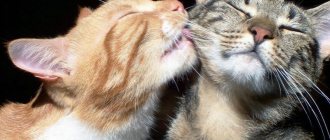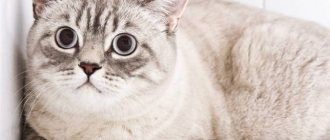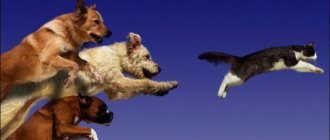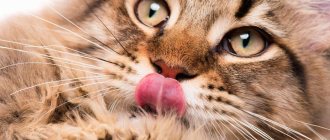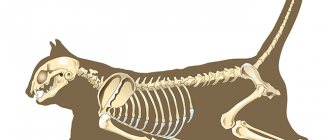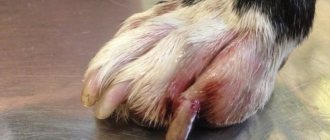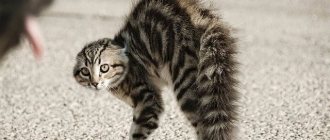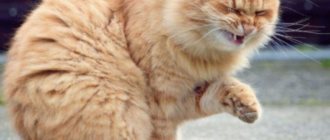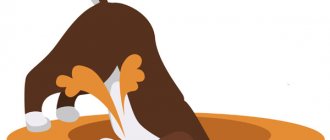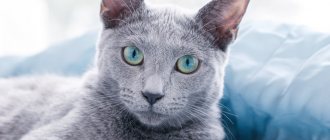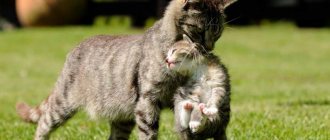Attentive pet owners do not lose sight of even the slightest behavioral features of their charges. Many people are interested in the question of why a cat sometimes jerks its tail, making sudden movements in different directions. This is due to various reasons. The tail is the most mobile part of the animal's body, consisting of many vertebrae. The functions it performs include the expression of the cat’s feelings and emotions.
How cats communicate using their tail
In a cat society, the tail is simply irreplaceable. With the help of this part of the body, cats can express their attitude towards each other without uttering a sound.
Serious cat
The cat twitches its tail, and it is raised by a “pipe”
This is how the cat expresses pride in himself and his appearance. The cat feels confident in the circle of those present. Or the pet is very happy about the long-awaited meeting with the owners.
For your information! Showing self-confidence, cats can lick in front of unfamiliar animals and people.
The tip of the tail moves from side to side
This is how the animal shows curiosity, keen interest and some apprehension. This is usually how cats behave when meeting a new resident of the house.
Important! At the moment when the cat is excited, he is easily scared. Therefore, owners need to be careful not to frighten their pet. It is necessary to calm the kitten: pet it, scratch it.
If a cat looks around in fear and shakes its hooked tail, then something or someone is irritating it. Perhaps this is how the pussy tells its owner or pet that it does not intend to play or is not in the mood to communicate.
The fur on the tail is ruffled
In this situation, the cat is preparing to attack unexpectedly, so owners need to be vigilant. Perhaps, in this way, the cat is honing its hunting skills through play, or the pet is very irritated.
Annoyed cat
The cat's tail is shaking... in his sleep
You've probably seen your pet purring when he's taking a leisurely nap. Or maybe you've noticed that his body, including his whiskers, paws and tail are shaking. According to scientists, this may mean that your little predator is dreaming of something interesting, for example, chasing his favorite toy or... a mouse.
However, this is not the only possible reason. A moving tail when a cat appears to be dozing may mean that the cat is not sleeping at all, but is simply relaxing. However, he is still aware of what is happening around him. Most often this happens when the cat is resting near the window, and very interesting sounds are heard outside.
Source
Why do cats shake their tail?
Watching the cat, breeders wonder why the cat develops new behavioral characteristics - the tail is shaking. To give an accurate answer, you need to understand the details of this phenomenon.
The cat is coughing: why it wheezes, the reasons, as if it was choking
A restless cat holds his tail in a horizontal position. If a cat's tail occasionally trembles and he looks around in fear, with his ears pressed to his head, this indicates the animal's alertness. If there is an object of irritation in the room, then it should be removed from the cat’s field of view, otherwise the animal may panic, and the further outcome of the actions of a frightened animal is unpredictable.
Note! But if the tail sways from side to side, you need to be prepared for a sudden attack by your pet, however, such a command from a pet does not always foreshadow a threat. Similar habits can be observed while playing with an inanimate object. Cats, parading their ancestors, attack their toy.
Cats, like humans, can express doubt when they need to make a choice. Living for several thousand years side by side with people, the descendants of tigers began to adopt some of the habits of the supreme being. While in thought, a person can rhythmically tap his fingers on the table or swing his leg. Likewise, a cat, which is faced with a choice, begins to involuntarily twitch the tip of its tail; the pussy holds the base of the tail straight. Moreover, in such a situation, only the tail is involved, that is, no other peculiarities in the cat’s behavior are observed. To stop flinching, you just need to help your pet make a choice.
The cat also twitches its tail, expressing a feeling of satisfaction. When the cat is calm, fed, and happy, he slowly raises the tip of his tail up and down. Also, such behavior indicates reciprocal feelings for the owner’s affection, so a representative of the cat family expresses gratitude to a person, and the cat purrs and, perhaps, rubs against the owner’s hands, walks around the owner. In addition, by twitching its tail, the cat informs others that what is happening in the room completely satisfies it.
Often the reason for a wagging tail is interest. Movements of the tail are carried out slowly and to the beat, but the general appearance of the animal remains unchanged, all the cat’s attention is focused on one object. This usually happens after the owner goes to the store; in such a situation, the subject of the cat’s examination becomes a bag of food. A pet, showing interest in something, watches with caution, sniffs, carefully examines the object, sometimes engrossed in its occupation, and prevents the owner from passing.
Note! To accurately determine why your beloved cat's tail is shaking, you need to be attentive to details, namely, the environment in which the animal is located, the general appearance of the cat and the pet's surroundings at the moment.
Reason #4: joyful excitement
A slight shaking of the tail is also characteristic of joy. At such moments, he is proudly raised “pipe”, and the cat itself purrs contentedly, rubs against objects and arches its back. The reaction is observed when meeting the owner after work, while waiting for food and immediately after feeding. You need to act according to the situation:
- Greetings. Be sure to pet your pet and pick it up if he doesn’t mind.
- Waiting for food. Here, you are only required to serve on time, as your legs may suffer due to the long wait.
- End of feeding. At the end of the meal, the cat tries to thank you for the delicious lunch, but you can also praise or pet it in return. Regularly receiving approval from the owner normalizes appetite. This is especially important for those who eat less than their norm.
A similar gesture is used to invite people to play. Due to excitement, the cat may shift from paw to paw.
Some animals openly declare their intentions and bring toys to their owner. This behavior should be encouraged. If you are busy, give your pet at least a few minutes. This will strengthen your connection.
The cat is shaking its tail: what is its mood?
Why do cats wag their tail: what does it mean?
Like people, cats have a body language that can be used to determine the animal’s state of mind. So, the owner, by looking at the cat, can understand whether the cat wants to play, or whether it is better to leave the pet alone.
- If a cat intends to play with a person, he expresses this with a slight twitch of his tail directed vertically upward. If during play the cat begins to loudly lash the floor with its tail, then everything should be stopped.
- A pet's irritation can be easily determined by the nervous twitching of its tail in different directions. Sometimes an indicator of an irritated state is a tail raised up, with its tip bent in a hook.
- Another reason for tail shaking is a feeling of stress, some fear. Your pet may be experiencing pain. If a cat is worried about something, it usually taps its tail on the floor with small shot, and the general appearance of the animal is full of thoughtfulness. To eliminate the possibility of your pet becoming ill, it is necessary to examine the animal as soon as possible and take appropriate measures.
- If the fur on the cat's back is tousled and the tail flicks from side to side, you must be careful and attentive when interacting with your pet, as the animal may suddenly attack.
Reason #5: irritation and anger
Rhythmic movements in different directions, accompanied by frequent and loud knocking on the floor, mean irritation. To calm your cat, you will need to find out what is causing her anxiety. Most often, animals are disturbed by large crowds of people, strangers in their own home, prolonged absence of the owner, loud sounds and strong odors.
Try picking up and cuddling your cat, then direct her attention to her favorite toys or treats. Remember that not everyone enjoys communicating with other people, so in such cases, a mustachioed pet needs a house where it can hide and be alone.
When very irritated and angry, the tip of the tail bends into a hook. In this state, it is better not to touch the cat. Instead, you should look for the sources of her discontent and try to eliminate them.
In addition to the position of the tail, the following signs will help recognize aggression:
- pressing the ears to the skull;
- arching the back;
- dilated pupils;
- snorting and threatening hissing;
- fluffy fur along the spinal column;
- release of claws;
- demonstration of teeth.
It is recommended to leave a frightened pet alone.
The same applies to the reaction to affection. Braking during sleep is not a good idea. Try to respect your pet's personal space and only pick her up if she has given her consent.
Sometimes anger is caused by unattainable objects: birds and other animals outside the window. In this case, aggression is redirected to what is nearby. A single attack on your legs due to an unsuccessful pigeon hunt is prevented by throwing a blanket and urgently taking the aggressor to another room. If such attacks become more frequent, consult a veterinarian. Sedatives may be required to suppress aggression.
Other communication options
The movements of cats are so varied that every slightest twitch indicates a change in mood.
Why does a dog chase its tail?
If a cat, upon seeing its owner, suddenly raises its tail and runs headlong towards him, this is a good sign. Sometimes a cat expresses greetings to its fellow cat in this way. Such a rush of joy can be accompanied by a ringing and drawn-out purr and arching of the back.
By turning his back to the owner and simultaneously raising his tail, the cat expresses sincere trust and respect for the person. Usually cats are very cautious and distrustful animals, so if the breeder saw such a gesture from a pet, he deserved a certain favor from the cat.
You can often watch a cat proudly striding down the street with its tail raised like a pipe. Such a gesture can be deciphered as a signal of dominance over its relatives. The cat shows with all his appearance that he is the main male of these surroundings.
Important! If a person witnesses that a small predator has raised its tail up and bent its tip, this means that the cat’s personality should not be disturbed. This behavior in a cat can be noticed while eating.
If the cat's fur is tousled, the skin is shriveled, and the tail is slightly raised above the ground, then the pet is ready for a fight with a relative. The fact is that cats have peculiar fights. These animals rarely cause physical damage to each other, since wounds in felines heal very slowly. The males take on intimidating poses and begin to howl loudly at each other. The one who cannot withstand the moral pressure of his opponent is the one who is defeated.
Cat fight
Wagging its tail back and forth, like a rattlesnake, means that the cat is very angry and confused. In such a situation, it is better to leave your pet alone.
If a cat hits its sides with its tail, strongly arching its back, you need to be vigilant, since the animal can attack at any moment. If a cat wags its tail in different directions, but at the same time maintains its equanimity, it means that it is in control of the situation. As soon as the room is safe enough, the pet will fall asleep and stop its activities.
If a cat's tail occasionally twitches in small bursts while near a tree, bush or some other object on the street or indoors (house, apartment), then most likely the animal is marking its territory. If the owner wants to avoid further occurrences of such twitching, it is necessary to have the cat spayed at a veterinary clinic.
For your information! Another reason for constant tail twitching is the cat's desire to go to the toilet.
Knowing what causes tail wagging can help determine your cat's needs. The ability to recognize the true intentions of an animal will help to establish a relationship with a person.
Symptoms
Symptoms of feline hyperesthesia can develop at any age, and the condition can occur in all breeds. A cat that suffers from hyperesthesia syndrome may end up licking and biting its own body, such as its limbs, tail and back.
Slanimsky Alexey Georgievich
Veterinarian of the highest qualification category. Has extensive experience in diagnosing and treating diseases in animals.
Important! It is still not known for certain why this disease occurs, but it regularly burns nerve cells for cat breeders. As a rule, the manifestations of this pathology can be managed with sedatives, which your veterinarian can prescribe to the cat.
Here are some other signs that your cat may have hyperesthesia:
- The skin on your cat's back may range from the shoulders to the tail
- Your cat may suddenly jump and turn towards her tail as if something is bothering her
- You may notice muscle twitching, tail twitching, and/or muscle spasms
- Your cat may not like certain areas of its back to be touched when you go to pet it
- Your cat may act erratically, appear agitated, and have dilated pupils
- Your cat may cry, hiss, or suddenly run away, and you may think she's hallucinating because she looks like she's going after something that isn't there.
- Severe cases can lead to self-destruction through chewing, licking, fur pulling, and biting. As a result, lesions and infections may appear on the skin.
Typically, these symptoms occur in episodes that may last only a few seconds or a few minutes. In between episodes, your kitten will act as if everything is fine. However, touching your cat in the wrong place can trigger an episode.
Diagnosis
By the way, how can you tell if your cat has abdominal cramps? Unfortunately, there are enough external signs of this: the animal may “scream” in a voice that is not its own, lie writhing in pain, and in milder cases, vomiting is observed. Severe profuse diarrhea cannot be ruled out. If something like this is observed when you try to go to the tray “in a small way,” then you are probably dealing with kidney spasms.
On the way to the veterinarian (and you need to take your cat there urgently), think about what the animal ate and drank before the attack began, whether it is suffering from any infectious diseases, whether the cat could have eaten a poisoned mouse, etc. The more data you can give the doctor, the greater the chance of identifying the problem as quickly as possible.
A biochemical and complete blood test is done, and a urine test is taken. In addition, those diagnostic techniques that allow you to examine the abdominal cavity and its organs “from the inside” are of great importance. These include radiography and ultrasound.
Attract attention
It is also possible that the animal has this behavior because it is jealous
the arrival of a new person in the house. Cats are very territorial and don't take change well, so if a child arrives or sees a new animal in your home, it's best to spend some time introducing yourself and letting your cat get used to this new presence.
In this sense, the animal will bite its tail only to attract attention
Although they are very independent, the truth is that they place great importance on love and want to feel loved. Therefore, if they feel that you are paying attention to other members, they may act in this peculiar way
Shape matters
The cat's “fifth limb” can have different configurations and lengths:
- the Thai has an oblong thin tourniquet (25-35 cm);
- the Persian has a short, luxurious fan (20-25 cm);
- the bobtail has a short, almost round pompom (5-13 cm);
- the Cymric has a barely noticeable stump (2-5 cm).
Moreover, in all cats, the tails consist of several (from 2 to 27) vertebrae, connected by a jelly-like joint fluid. The presence of “lubricant” explains, from a biochemical point of view, why cats wag their tails.
The shape of the outermost caudal vertebra is fundamentally important for the exhibition life of representatives of the cat family. The slightest deformation - knot formation, bending, kink, crease - will not allow the meowing contestant to pass the strict judicial selection.
When to contact a veterinarian
If the owner, after analyzing his pet’s trembling on his own, does not find an explanation for it, he will have to immediately contact a specialist at the nearest veterinary clinic. As the animal begins to tremble, its behavior may change; overnight, a beloved cat may become aggressive. In addition to the reasons described above that cause tremors in a cat in a lying position, there are many other less harmless reasons that cause tremors.
These include:
- The cat has helminths.
- Lack of vitamins in the cat's body (especially calcium and vitamin B).
- Diseases of internal organs (in particular the kidneys - the presence of urolithiasis in the animal).
The veterinarian will send the animal along with the owner to undergo all the necessary tests and an ultrasound of the internal organs, and then give recommendations on the necessary treatment.
- Published in
- Health
Caution - rabies
If the cat is free-range, its behavior must be observed especially carefully. On the street there is a high risk of contracting various infectious diseases, many of which are fatal.
Having noticed a twitching of the tail and back of a freedom-loving cat, the owner needs to sound the alarm and find out why this is happening. These symptoms are often used to identify rabies. This disease is dangerous for both the pet and its owner. It threatens irreversible damage to the spinal cord and brain. In addition to the fact that the animal begins to twitch its tail and back, there are other signs of rabies :
- the cat eats food but refuses to drink water;
- the animal becomes aggressive or, conversely, tries to hide from people;
- have difficulty swallowing food;
- saliva is produced profusely;
- the pet begins to constantly bite itself at the place through which the infection entered the cat’s body.
But whatever the symptoms, only a veterinarian can accurately answer the question of why the cat is twitching its tail. However, if rabies is confirmed, the animal will have to be euthanized.
Treatment
If your kitten begins to show signs of feline hyperesthesia syndrome, it is a great idea to talk to your veterinarian, who will evaluate your pet and rule out other problems that have similar symptoms.
If hyperesthesia is the cause of your cat's symptoms, it is important to know that there is no definitive cure for this condition. Instead, your veterinarian may recommend giving your pet prescription medications such as anticonvulsants or antidepressants. Reducing your cat's stress and anxiety levels through environmental enrichment may also be helpful, or you may be advised to make changes to your kitten's diet. Additionally, natural remedies such as acupuncture, massage, and supplements may also be recommended.
Associated symptoms
The red cat is trembling, why?
Let's take a closer look.
Subclinical form of panleukopenia
In the subclinical form of panleukopenia, the cat develops lethargy and fever.
- The subclinical form of panleukopenia often does not manifest itself with pronounced symptoms, so timely diagnosis is especially important.
- The latent period of this disease lasts about ten days, then lethargy and fever appear.
- The cat refuses food and water and is very thirsty.
- Vomiting, diarrhea, and bloating are possible.
Hidden period of rhinotracheitis
Apathy and loss of appetite appear in a cat with rhinotracheitis.
- The first signs are apathy, loss of appetite, and fever.
- Serum nasal and eye discharge.
- Over time, they turn into purulent mucous discharge and increased salivation.
- Ulcers develop on the tongue, and parenchymal keratitis occurs.
Calcivirus infection
Calcivirus infection can be expressed by discharge from the eyes.
- In healthy and strong animals, it can occur in a latent form and manifest itself only as a slight tremor.
- However, when it develops into a chronic stage, it causes irreparable harm to the pet’s body.
- It can be expressed by slight discharge from the nose and eyes, lameness, apathy, and lethargy.
- A slight fluctuation in the body’s protective function and the disease becomes acute.
- The danger is the rapid course of the acute form and the development of secondary pathologies.
In this case, an unfavorable and cautious prognosis is made.
Puberty of a cat
One of the reasons for trembling is puberty in a cat.
If this is a young animal, such a condition causes unreasonable fear and, as a result, stress.
Central nervous system disorders
With meningitis, depression will be present.
- With meningitis, depression, low blood pressure, and fever will be present. Severe, continuous vomiting may occur.
- Symptoms of myelitis may not appear immediately.
- The initial stage is characterized by constant attacks of anxiety.
- Then severe pain, aggression, and loss of coordination with partial paralysis occur.
- The animal is constantly trembling, there is hyperthermia, difficulty urinating and defecating.
- Neurosis manifests itself in the inappropriate behavior of an animal.
- This may be an unreasonable fear of familiar things and events - feeding, one’s own habitat, the owner.
- Fear of closed spaces or litter boxes.
- Aggressive behavior gives way to complete apathy.
- Prolonged licking of the fur until it is wet.
What else you need to know about cat "language"
When a kitten shakes its tail, this may also mean it is time to mark its territory. The cat begins to mark and finely wags its tail, which becomes a natural reaction of the muscles to the act of the four-legged cat.
It’s easy to overcome this “habit”: you need to castrate the cat. It is better to do this at an early age, when the pet’s body is strong and strong and is able to endure any operations.
The behavior of a cat with a chaotically shaking tail can be attributed to ill health. If your pet begins to twitch its tail and shake its hind legs, you should see the animal to a veterinarian. Common causes include: pinched nerves, increased stress, inflammation of the anal glands, fleas, lice, inflammatory formations that cause painful discomfort.
Attentive pet owners do not lose sight of even the slightest behavioral features of their charges. Many people are interested in the question of why a cat sometimes jerks its tail, making sudden movements in different directions. This is due to various reasons. The tail is the most mobile part of the animal's body, consisting of many vertebrae. The functions it performs include the expression of the cat’s feelings and emotions.
Main predisposing factors
In many cases, this can happen due to various infectious and parasitic diseases, as well as their consequences. The most common reasons are the following:
- Damage to the gastric mucosa.
- Similarly - ulceration of the mucous membrane of the thin and thick sections of the gastrointestinal tract.
- Peritonitis of infectious etiology.
- Inflammation of the mucous membrane of the small gastrointestinal tract.
- Parasitic diseases.
- Pyometra or endometritis (indicated by discharge from the genitals).
- Abscesses of internal organs (especially in the liver and pancreas).
In all these cases, such a strong pain reaction develops that the intestines literally “twist” from spasms. But disease or parasites are not always to blame for a cat’s suffering. There are reasons for non-infectious etiology:
- Tumors of benign and malignant etiology.
- Poisoning.
- Birth defects.
- Abdominal trauma in which internal organs were damaged, or a strangulated hernia.
- Abnormal pregnancy. Possibly torsion of the uterus.
- Pinched nerves (due to injury, or congenital cases).
- Stones in the kidneys, bladder, urinary tract.
- Gallbladder obstruction, liver or gallstones.
- Intestinal volvulus, but for cats, is an extremely rare pathology that is more typical for dogs.
